By Noel T. Braymer
Transportation has always been central to land development. Major cities are always near transportation at harbors, rivers, the base of mountain passes and highway junctions. When new towns were being created in the 19th century in the United States, getting a railroad to put a station in at a town was the difference between thriving or seeing grass grow in the streets. The city of Los Angeles in the 1870’s was dead set on getting the new Southern Pacific Railroad to serve it. The Southern Pacific was laying track south from Sacramento through the Tehachapi mountains on its way to New Orleans. Los Angeles wanted the Southern Pacific to continue south down the Antelope and San Fernando Valleys to Los Angeles before heading east to Yuma where the best crossing on the Colorado River was to New Orleans. The Southern Pacific wanted the cheaper and shorter route to Yuma by heading east at what is now Palmdale and dropping down the Cajon Pass to Colton before turning east to Yuma. In a likely attempt to discourage the city of Los Angeles from asking for rail service, the Southern Pacific gave the city a bill for what it would cost to build the railroad to Los Angeles. The city leaders were shocked and angry at this quote, but raised the money to pay to extend the railroad which forced the Southern Pacific to go to Los Angeles. For years afterwords people in Los Angeles grumbled about the greedy so and so’s at the Southern Pacific. For the Southern Pacific it was over 90 years later in 1966 that they finished their preferred route between Palmdale and Colton.
From the late 19th to the early 20th Century wealthy speculators would often buy large parcels of cheap undeveloped land. Usually the first thing they would do is build a railroad to connect their property to other railroads to bring people to the property to buy lots for homes, farms and businesses. There are 2 major examples of such men in Southern California at this time. John D. Spreckels was the son of Claus Spreckels who made his fortune making sugar from sugar beets in Northern California. Before this Claus Spreckels also helped build the railroad in the San Joaquin Valley now owned by the BNSF. John D. Spreckels after moving to San Diego soon went to to work developing San Diego, starting with creating today’s downtown San Diego next to San Diego’s harbor. The original San Diego was 3 miles to the north along the banks of the San Diego River and the area now called Mission Valley near the first Spanish Mission in California. During this time Spreckels built the San Diego Streetcar system. He also owned ferry services and shipping companies in San Diego. But his biggest project was building a rail connection for the port of San Diego to the Southern Pacific which met it at El Centro. The Southern Pacific helped pay for the construction of this railroad called by many “The Impossible Railroad”. It wasn’t as successful as hoped and the cost of maintaining it wiped out most potential profits. Spreckels’ interest went beyond transportation in San Diego. He also helped build a water system for San Diego which was central to attracting people to move there. He was a major supporter of the 1915 Panama-California Exposition which celebrated the opening of the Panama Canal. It also brought many visitors to San Diego. Many of the buildings at Balboa Park today were built for the 1915 Exposition, as well as the current Santa Fe Depot in downtown San Diego which is still the train station for downtown San Diego.
An even better known local California businessman was Henry E. Huntington. He was the nephew of Collis P. Huntington, one of the “Big Four” of the Southern Pacific. Henry E. Huntington is best known for owning the Pacific Electric Interurban railroad which connected most of Los Angeles County to parts of Orange, San Bernardino and Riverside Counties. I once bought a reproduction of a Pacific Electric magazine at the Orange Empire Museum at Perris. What I remember most about this publication were the many ads of land for sale near stations of the Pacific Electric Railroad. The Pacific Electric Railroad never made much money carrying passengers. Most of what money the Pacific Electric made was carrying freight. It usually lost money. But Huntington, like Spreckels invested and controlled many other businesses besides railroads. More important to Huntington was that he owned what is now the Southern California Edison Company. Some of the first electric generators installed in Southern California were placed in Long Beach to power the Pacific Electric trains. But more than that, as they electrified the railroad, the Edison Company also electrified miles of open land near the Pacific Electric to provide electricity to the new homes and businesses on the lots people bought after traveling on the Pacific Electric to find their dream property.
The transit company in Hong Kong makes money, it has for years going back to the days of British rule. Would the reason be because of the high population density of Hong Kong? Or the difficulty of trying to drive in Hong Kong with few roads or places to park? The main reason the transit company (it is and always had been a privately owned company) is profitable is because it owns developed land next to the stations of its transit services. The rents of buildings on the land owned by the transit company is the reason why the transit company makes money. But this land wouldn’t be nearly so valuable without the transit service bringing people to or from the properties owned by the transit company.
This summer will see the start up of a new, privately owned passenger railroad in Florida called Brightline. It will start between Miami and West Palm Beach and later will be extended to Orlando. It is being built for the Florida East Coast Industries company which is a land development company founded by Henry M Flagler. Flagler was also owner of the Florida East Coast Railway. Mr. Flagler was primarily in the land development business responsible for development of Miami Beach, West Palm Beach and St. Augustine in the late 19th and early 20th Centuries. The Florida East Coast Industries company has always been a land development company which also owned a railroad. The railroad was central to developing land in Florida, but the real money was made developing the land, not running the railroad. Now the new Brightline railroad is expected to operate at a profit which is normal for most intercity rail passenger services. There is interest in other places having Brightline create and operate other start up rail passenger services on other corridors outside of Florida. But the main interest of the Florida East Coast Industries company in building Brightline is from the money made building at and around the stations on land they already own. In downtown Miami Brightline is building a new train station. But the Miami Central Station is being build not just for Brightline, but also for the regional Tri-Rail train service and transit connections at the new station to Miami’s Metrorail, Metrobus and Metromover, the last of which is a free elevated People Mover circulator service for downtown Miami.
What is being seen in Southern California since the State of California started supporting rail passenger service between Los Angeles and San Diego in the mid 1970’s is major development around many of the stations. One problem in the past to riding trains in Southern California was that the locations of the stations were generally not in a part of town people wanted to go too. Most of the old Santa Fe Stations in Southern California were in industrial or warehouse districts of towns and cities. The primary business of the Santa Fe was freight, and businesses using the Santa Fe for freight were often close to the tracks. The stations also worked for the freight as well as the passenger side of the business. In the case of Oceanside before 1984 the station was also the site of a railroad freight yard. Services such as hotels, restaurants, parking or transit were also limited at many of the stations. Many places had little or no population before World War II. But by the 1970’s were major population centers but with no nearby train stations. The first major turnaround when it came to stations started with the opening of the new Oceanside Transit Center in 1984 as one of the first new train station in the US since World War II.
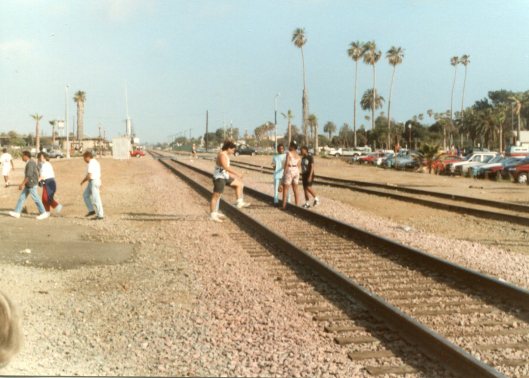
This is a view north of the Oceanside Transit Center looking south in the summer of 1991, seven years after it opened. I was taking these pictures to document the problem of trespassers on the railroad. In front of the train station is the Mission Blvd grade crossing. There is a red vehicle seen clearing the crossing in the background of this photo
Around 1970, a recently returned reserve Marine Major from a one year tour in Vietnam started thinking about what could be done with the old train station in Oceanside. After his return he bought a doughnut shop to go into business for himself in Oceanside and joined the Chamber of Commerce. He started talking about his ideas to other members of the Chamber. His basic plan was to create a multi-modal station. That meant combining as many “modes” of transportation as possible in one place. This would make it easier for passengers to travel by allowing passengers to make transfers in one place. This was common in many places in the world, but largely unknown in this country in 1984 1w. This would no longer be just a train station, but also the station for Greyhound and Trailways buses and for the transit buses in Oceanside to layover and make transferring between bus lines or to trains easier. Byron Nordberg was the reserve Marine Officer who planned the Oceanside Transit Center which opened in 1984. Central to his plan was replacing the old 1943 “temporary” Santa Fe wood and stucco station building with a new facility. Also critical was moving the freight yard out of downtown Oceanside. The station area was in the center of downtown Oceanside near the beach and pier. The area in the 1980’s was also seedy and rundown. These changes and improved transportation would encourage new construction in downtown with the plan to attract resort hotels to serve the nearby beach. What sold the members of the Chamber of Commerce was the new construction and broader tax base that this new transportation center could bring to Oceanside.
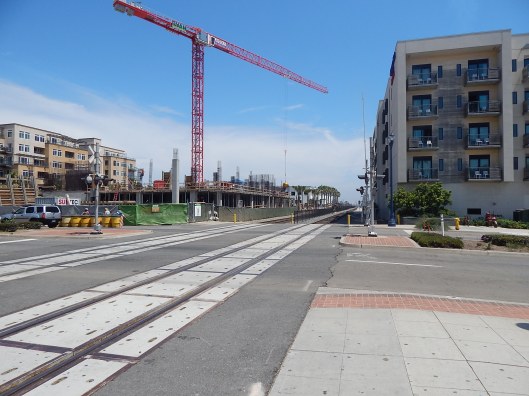
This is the view in the summer of 2017 at the Oceanside Transit Center next to the Mission Blvd crossing. At the left hand side are new apartments under construction . In the background are more apartments with retail services on the ground floor. On the right is the Oceanside Marriott SpringHill Suites resort hotel next to the station and tracks.
It wasn’t long after the Oceanside Transit Center opened that other cities in California started plans to copy many of the same ideas used in Oceanside. Over the years the rate of development around the stations has increased. In 1981 San Diego opened the San Diego Trolley light rail service. It used part of the old railroad built by John D. Spreckels to get to the Southern Pacific at El Centro. The Trolley first ran between the Mexican Border and the Santa Fe Depot in downtown San Diego. Several of the transit planners in San Diego thought it was a waste of money to extend the Trolley to the Santa Fe Depot. It soon became the busiest stop for the Trolley. Today there is much more Amtrak, Trolley and now Coaster commuter train service at the Santa Fe Depot. What is equally amazing is all the new construction in mostly the last 20 years around the tracks and Santa Fe Station in San Diego. Many of the buildings are hi-rise apartments and condos. There are million dollar high rise condos along the tracks now in downtown San Diego what not long ago was a run down part of town.
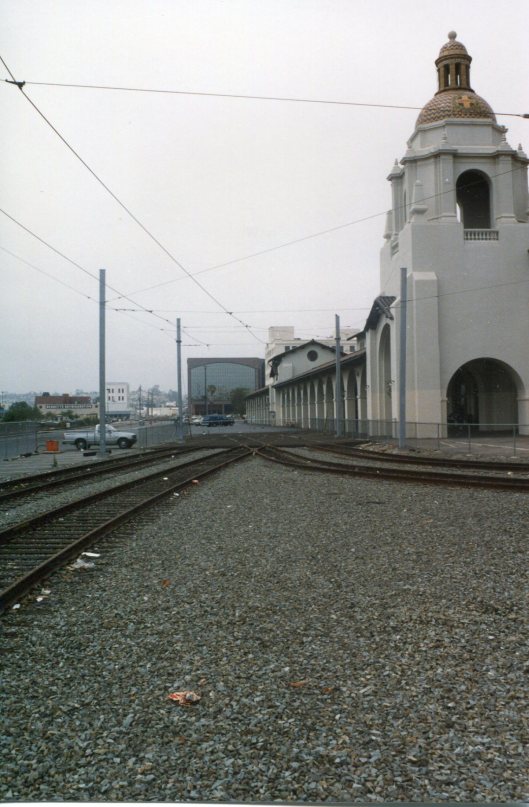
This is a view of the area around the Santa Fe Depot in downtown San Diego around 1990. This picture shows show new tracks built to extend the San Diego Trolley to the Depot which latter were extended further north to Old Town.
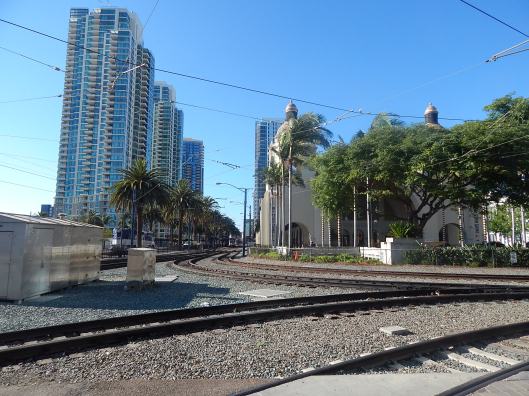
This is a picture from the summer of 2016 along the same trolley tracks of some of the development around the station today.
Perhaps what is most amazing is the rapid change around downtown Los Angeles. A major problem trying to build in Los Angeles County, particularly new housing is because of opposition to new development by local residents. Their main complaint is fear of more traffic because of higher housing density. About the only place that is seeing major new construction including housing is in downtown Los Angeles. Much of this new construction is in older parts of downtown and the old warehouse and industrial parts by the river and railroad tracks. In 2011 LA Metro which controls transportation in Los Angeles County bought Los Angles Union Station. Their plan is to transform this iconic part of Los Angeles into the surface transportation hub of Southern California. This will include a new concourse which will reduce overcrowding at the station and make it easier to connect to other trains and rail transit. It will also include more retail and food services. A critical part of the remaking of Los Angeles Union Station will be new platforms and tracks for run through service for High Speed Rail, Metrolink and Pacific Surfliner trains. There are also plans to build a major hotel at Union Station and new commercial high rises around the station. LA Metro is also overseeing getting new housing and retail construction built near its rail transit stations. Hopefully several of these developments will also improve the revenues of LA Metro.
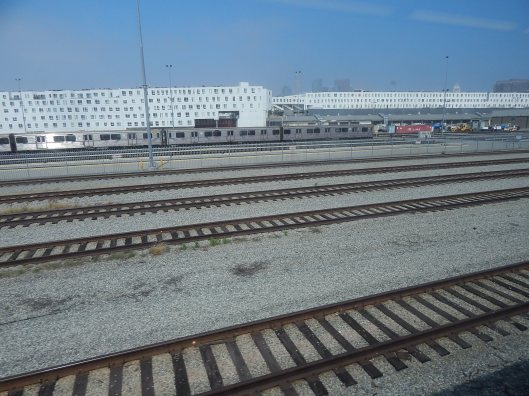
This is the view from the train in downtown Los Angeles. This is along the river and is also the site of the maintenance yard for the Red and Purple lines of LA Metro rail service. The long rows of white buildings behind LA Metro’s rail yard are fairly new high density housing. Such construction was possible in this industrial area because few people were in the area to complain. Now that LA Metro is planning to expand their yard to handle more railcars for the extension under construction of the Red line to Westwood, their new neighbors in the white buildings are complaining about LA Metro’s construction plans.
So often the critics of rail passenger service cry about it loses so much money and so claim it is worthless. What is often forgotten by these folks is the role of transportation, particularly rail service to a healthy growing economy. If you want a see a place that is poor and rundown, its usually where roads are empty, rundown, potholed and go nowhere. To me, trains are a form of horizontal elevators. I mean has anyone ever complained that elevators don’t make money? Even if you tried to charge people to ride the elevators the cost of collecting fares would likely be more than any income they might generate. But owners of large buildings know that without fast and reliable elevators, they won’t keep tenants willing to pay rent for using their buildings. Charging people to ride trains does makes more sense than for elevators. But the real money to be made is not from running trains. Its from the economic growth made possible with rapid and efficient rail transportation.
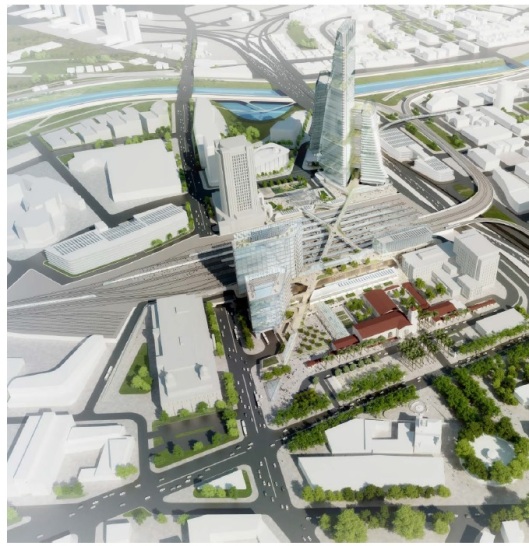
This is the masterplan for development at Los Angeles Union Station. This is the view looking east and north is on the left hand side. The new tall building along the west side of the tracks at the north end of the station is the site for a proposed new hotel at LAUS. At the east end of the tracks on the south side are some of the new high rise office buildings proposed for LAUS. The new run-through tracks of the station can be seen at the right south end of the station turning east to connect with tracks along the LA River running north/south.

The re-development around Union Station especially to south around Little Tokyo and the Arts District has been nothing short of magnificent. What was once a derelict area is now filled with night life and new business, all due to metro rail improvements. A hotel on Union Station property should be a priority along with run-through tracks. I hope the new hotel will have a pool.
LikeLike